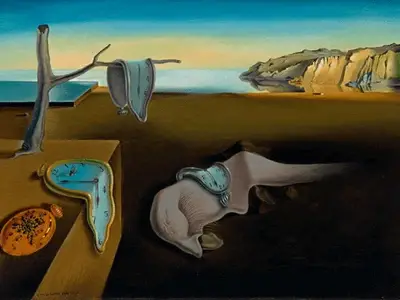Title of Artwork: “The Persistence of Memory”
Original Title: ‘La persistencia de la memoria’

Artwork by Salvador Dali
Year Created 1931
Summary of The Persistence of Memory
One of the most famous Surrealist works, The Persistence of Memory (1931) is instantly recognised even to those unfamiliar with the movement.
The 24×33 centimetre canvas is sometimes referred to as “Melting Clocks,” “The Soft Watches,” or “The Melting Watches” in pop culture.
Watches, substantial and hard items appear to be mysteriously limp and melting amid the bleak environment, creating the impression of a dreamlike world shown in the artwork.
All About The Persistence of Memory
In order “to systemize confusion and so to assist invalidate entirely the realm of reality,” Dal paints his fantasy vision with painstaking realism, seamlessly blending the real and the imagined.
When asked about the limp watches, the artist said they represent “the camembert of time” because of their similarity to ripe cheese. The left gold watch, which is overrun by ants, best illustrates the concept of deterioration.
Dal’s frequent use of ants as a subject is typically associated with morbid themes like decay and death. The barren setting was most likely based on the coastline of Catalonia, his own country.
Another feature of the painting reveals the Catalan landscape’s influence: the artist places himself into the scene as a bizarre squishy creature at the picture’s focal point. Dal claimed that he was inspired by a rock formation in Cap de Creus, which is located in northeast Catalonia.
Scholars have also noticed similarities between the self-portrait and the right side of the left panel of Hieronymus Bosch’s The Garden of Earthly Delights (1510-1515).
Dali’s large nose and long eyelashes are reflected in the conspicuous features of rocks, shrubs, and little animals that Bosch paints.
Different iterations of this self-portrait can be seen in other Dal works, such as The Great Masturbator (1929).
One of Dal’s most iconic and potent motifs, the melting watch, persisted throughout his career. Dal painted The Disintegration of the Persistence of Memory twenty years after his groundbreaking piece, The Persistence of Memory (1952-1954).
The title alludes to the work depicting the collapse of the globe represented in the original work, which is reflective of a world altered by the nuclear age.
By including rectangular blocks representing “the atomic power source” and missile-like items alluding to the atomic bomb, Dal demonstrated his growing interest in quantum physics in this painting.
Towards the end of his life, Dali made a number of sculptures depicting melting timepieces. These include The Persistence of Memory (ca. 1980), Profile of Time (1977–1984), Nobility of Time (1977–1984), and Dance of Time I (1984). (1979-1984).
Opening in New York City’s Julien Levy Gallery in 1932, The Persistence of Memory was a hit with audiences. The picture was given to the Museum of Modern Art in New York in 1934 and has been there ever since.
Information Citations:
En.wikipedia.org, https://en.wikipedia.org/.























